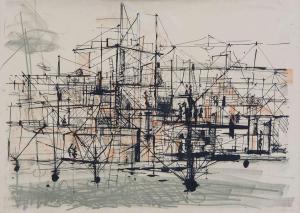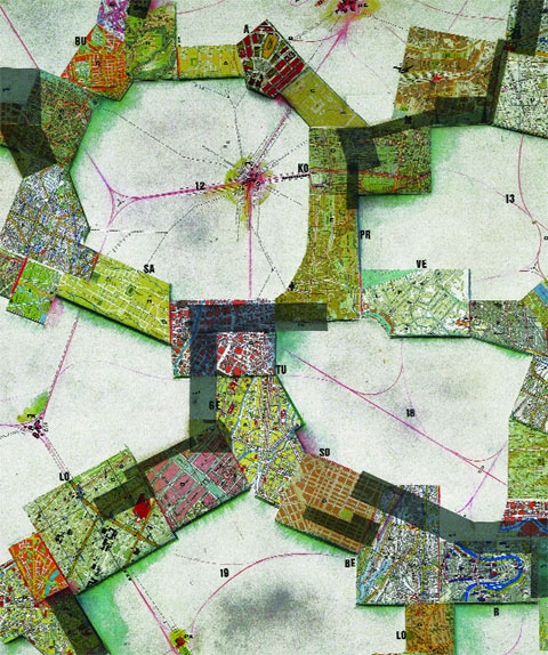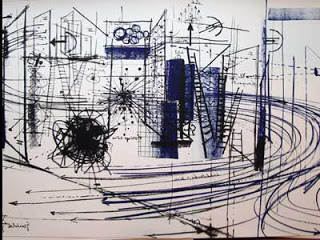New Babylon


If there was a high point for the radical imagination of a future for the planet, perhaps it was Constant Nieuwenhuys' New Babylon. Constant was a key member of the Situationist International in its early phase. He started work on New Babylon before he resigned from it, and continued working on it for many years. It embodied many of the situationosts' key ideas about constructing situations for permanent play, but here imagined at the scale of an infrastructure for a planetery utopia dedicated to nomadic play. Here's a few extracts from my book The Beach Beneath the Street about this amazing work.
New Babylon
Constant built a future out of offcut plexiglass and bicycle spokes.
Later he would say that his marvelous models of New Babylon were appreciated in much the same way as African masks were in surrealist times, as interesting forms, but stripped of their magical significance. What is lost from New Babylon is a passion gone from the world, a desire to seize the world itself as the object of desire, to find a form for the whole of life.
Constant had photographs made of New Babylon, and a film. He produced a newspaper for it, and he gave his famous lecture performances. All to conjure into being a landscape that envisioned what was possible right here and now, but was held back by the fetter of outdated relations of production. It was not a utopia. “I prefer to call it a realistic project, because it distances itself from the present condition which has lost touch with reality, and because it is founded on what is technically feasible, on what is desirable from a human viewpoint, on what is inevitable from a social viewpoint.” The question that lingers is not whether New Babylon was merely a dream, but whether actually existing built form is really a nightmare.
Rather than demolish the old world to build a radiant city; rather than build a garden city on greenfield sites, Constant cantilevers new spaces up above, leaving both city and countryside untouched. Automated factories would be underground, the surface level is for transport, while up above stretches a new landscape for play, a massive superstructure of linked sectors, within which everything is malleable, changeable at whim. Considered vertically, as an elevation, New Babylon makes literal Marx’s diagram of base and superstructure. Its airy sectors are literally superstructures, made possible by an infrastructure below ground where mechanical reproduction has abolished scarcity and freed all of time from necessity. It is an image of what Constant imagines the development of productive forces has made possible, but which the fetter of existing relations of production prevents from coming into being.
New Babylon responds both to the expansion of material resources and the expansion of population. Like a suburban family that adds a new story when the second kid is born, Constant builds a second deck—for the whole planet. Rather than suburban sprawl inserting itself into any and every terrain, he leaves much of the old world intact—including, interestingly, the classic spaces of the dérive in the heart of the old cities such as Paris and Amsterdam. The Les Halles of which Abdelhafid Khatib was so fond would remain. This is a new world that expands, not horizontally but vertically. It is a “a new skin that covers the earth and multiplies its living space.” Not the least charm of New Babylon is that Constant thinks the planet is a robust enough foundation on which to build such a bold addition.
Like many others at the time, Constant was influenced by the cybernetic theories of Norbert Wiener (1894–1964), particularly his notion of a second industrial revolution. Wandering the streets of London and Manchester, Friedrich Engels movingly recorded the human misery that resulted from the first one. It confounded modern artists, who felt compelled to either reject industry or embrace it. The alternate utopian visions of William Morris and Edward Bellamy represented these two seemingly incompatible options. As Henri Lefebvre might say, they détourned the resources of romantic dissent against the rise of capitalism, drawing respectively on its visions of a cosmological and an anthropological order. But this debate was now moot. The first industrial revolution had given way to the second, a revolution in the use of information as a means of control.
Cybernetics might just provide the means of mitigating the damage of the first industrial revolution, while building on its enormous expansion of productive potential. Or, it could result in what Wiener called the “fascist ant-state.” Constant takes to heart Engels’s formula that communism reduces the state to the administration of things. Cybernetics as control is relegated below ground, to the world of administered things. Cybernetics as freedom, as the ability to connect anywhere, anytime, is in play up above. Constant pushes the debate about technicity to both extremes at once: total control and total freedom. By thus exacerbating the instrumentalizing tendencies of cybernetic control, freedom from necessity appears in the realm of the possible.
Constant’s multi-level layout borrows a recognizable figure from modern architecture. The space-frame suspended in the air on pylons appears in the work of Le Corbusier, and becomes an image of utopian form in Yona Friedman. Constant greatly expands its significance. In his hands it becomes the image of a world in which the time of free movement takes priority over the space of private property. Fencing off one space from another as private property is for Constant a “dehumanization of the earth,” against which New Babylon presupposes “the socialization of the earth’s surface.” Rather than lines that make borders, Constant’s experimental geography proposes lines that make connections. His vast aerial sectors, the size of little cities, link up and spread out over the landscape like reinforced-concrete crabgrass.
Owning property affords someone a house in which to be at home, at the price of being homeless in the world. Dispense with property, dispense with separation, and the feeling of being merely thrown into the world goes with them. Our species-being can give vent to its wanderlust, at home in a house-like world. Constant thought modernity was already accelerating a return to a nomadic existence. New Babylon is nomadic life fully realized. It is an architecture of duration, of thresholds, of collaborative place-making, writ large. Freed from the fixity and uniformity of property, space could again have its qualities. A short trip in New Babylon should offer more variety than the most interminable journeys through the concentrated city of spectacular society. “Life is an endless journey across a world that is changing so rapidly that it seems forever another.” The New Babylonians could wander over the whole surface of a world that was in flux. “New Babylon ends nowhere (the earth is round).”
Beneath the ground, the automatic factories; across the surface, endless highways; and up above—a global network of superstructures, within which play takes place. Without borders, without centers, without a state, it snakes and forks all over the map. New Babylon “is organized according to the individual and collective covering of distance, of errancy: a network of units, linked to one another, and so forming chains that can develop, be extended in every direction.” And above that, figuratively at least, up in the ether, is another network, of communication. Constant intuits some things about what will turn out to be the internet. “The fluctuating world of the sectors calls on facilities (a transmitting and receiving network) that are both decentralized and public. Given the participation of a large number of people in the transmission and reception of images and sounds, perfected telecommunications become an important factor in ludic social behavior.” Interestingly, Constant’s vertical arrangement also corresponds to his friend Henri Lefebvre’s total semantic field, with cybernetic signaling at the base and symbolic play at the summit.
Through a decentralized network of communication, a nomadic species of play-beings coordinates its frolicking, designs and redesigns its own habitat, and creates a life where “the intensity of each moment destroys the memory that normally paralyses the creative imagination.” Constant experiments with a geography for a world beyond spectacle, where dérive and détournement are generalized practices, and indeed become the same practice. Both physical space and the space of information belong to everybody, and are resources for a life without dead time. It’s a world not only made for but made by homo ludens, whose species-being is play. The only question is whether we are, or could become, such beings. New Babylon may very well be a critique of the limits of our species as we know it.
Here is the architecture that Guy Debord and Ivan Chtcheglov only dreamt of as they wandered the streets of Paris: “Every square mile of New Babylon’s surface represents an inexhaustible field of new and unknown situations, because nothing will remain and everything is constantly changing.” Constant wanders far beyond his erstwhile comrades, if at the risk of an absolute euphoria. For Constant, the Situationist International “did not constitute a real movement. The adherents came and went and the only view they shared was their contempt for the current art practice.” He does credit the movement with contemplating the end to culture conceived as scarcity and property, and pursuing this possibility to its conclusions. “Unlike other Situationists, I realized straight away that the theory of unitary urbanism was not primarily concerned with micro-structures or with ambiences. On the contrary, these depend largely on the macro-structure ...” Those who design the future by halves plot their own graves.

Is it possible to imagine collective human agency as productive of something playful, joyous, communal, even beautiful? “The culture of New Babylon does not result from isolated activities, from exceptional situations, but from the global activity of the whole world population, every human being engaged in a dynamic relation with his surroundings.” New Babylon extends the ethos of the dérive to its limit, to world history. It is ultimately a philosophical work. “New Babylon is not a town planning project, but rather a way of thinking, of imagining, of looking at things and at life.”30 It is the disintegrating spectacle in negative. The great abundance really came to pass, only rather than free itself from labor, our species-being decided to labor making more and more things. “The growing presence of excess human energy has started to make itself felt.” But rather than outlets for joy—outlet malls. The disintegrating spectacle in which we actually live is the most utopian world of all, because of its savage insistence that it has abolished the very possibility of utopia for all time.
Walter Benjamin once drew a distinction between the fascist tendency to aestheticize politics and the revolutionary potential of a politicized aesthetics. Constant retrieves the formula for an era way past the promise of art. It’s a choice between a techno-fascist technologizing of aesthetics and the possibility of an aestheticizing of technology. Constant does not make a fetish of technology, as either saving grace or iron cage. Rather, it’s a question of thinking the possibilities of social and technical transformation together. The essence of technology is nothing technical. But could it be something playful? Could it be a way, not of instrumentalizing nature, but of producing a new relation to it, as a totality? Such were the scale of Constant’s ambitions, the ambitions really of a whole way of life. One which leaves behind beautiful objects as unreadable as African masks.